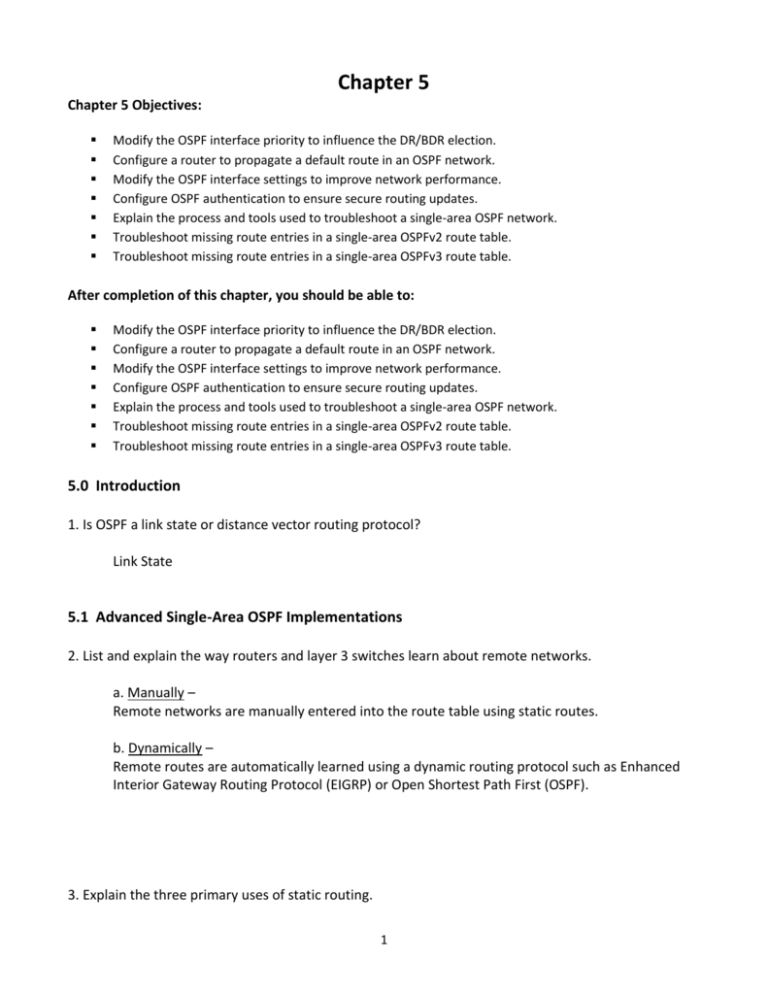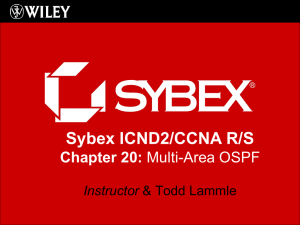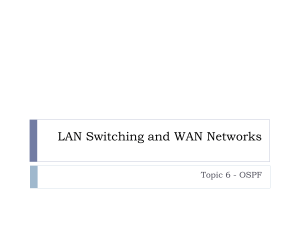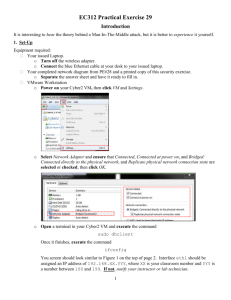Chapter 5 - Reading Organizer
advertisement

Chapter 5
Chapter 5 Objectives:
Modify the OSPF interface priority to influence the DR/BDR election.
Configure a router to propagate a default route in an OSPF network.
Modify the OSPF interface settings to improve network performance.
Configure OSPF authentication to ensure secure routing updates.
Explain the process and tools used to troubleshoot a single-area OSPF network.
Troubleshoot missing route entries in a single-area OSPFv2 route table.
Troubleshoot missing route entries in a single-area OSPFv3 route table.
After completion of this chapter, you should be able to:
Modify the OSPF interface priority to influence the DR/BDR election.
Configure a router to propagate a default route in an OSPF network.
Modify the OSPF interface settings to improve network performance.
Configure OSPF authentication to ensure secure routing updates.
Explain the process and tools used to troubleshoot a single-area OSPF network.
Troubleshoot missing route entries in a single-area OSPFv2 route table.
Troubleshoot missing route entries in a single-area OSPFv3 route table.
5.0 Introduction
1. Is OSPF a link state or distance vector routing protocol?
Link State
5.1 Advanced Single-Area OSPF Implementations
2. List and explain the way routers and layer 3 switches learn about remote networks.
a. Manually –
Remote networks are manually entered into the route table using static routes.
b. Dynamically –
Remote routes are automatically learned using a dynamic routing protocol such as Enhanced
Interior Gateway Routing Protocol (EIGRP) or Open Shortest Path First (OSPF).
3. Explain the three primary uses of static routing.
1
a. Providing ease of routing table maintenance in smaller networks that are not expected to
grow significantly.
b. Routing to and from stub networks. A stub network is a network accessed by a single route,
and the router has only one neighbor.
c. Using a single default route to represent a path to any network that does not have a more
specific match with another route in the routing table. Default routes are used to send traffic to
any destination beyond the next upstream router.
4. What is a primary benefit of dynamic routing protocols?
Routers exchange routing information when there is a topology change
5. What are the two most common dynamic routing protocols?
a. EIGRP
b. OSPF
6. Can dynamic routing protocols advertise and propagate static routes in their routing updates?
Yes
7. What protocol was OSPF designed to replace?
RIP
8. List and explain OSPF features.
a. Classless –
It is classless by design; therefore, it supports VLSM and CIDR.
b. Efficient –
Routing changes trigger routing updates (no periodic updates). It uses the SPF algorithm to
choose the best path.
c. Fast convergence –
It quickly propagates network changes.
d. Scalable –
It works well in small and large network sizes. Routers can be grouped into areas to support a
hierarchical system.
e. Secure –
It supports Message Digest 5 (MD5) authentication. When enabled, OSPF routers only accept
encrypted routing updates from peers with the same pre-shared password.
2
9. List and explain the commands you can use to verify OSPF.
a. show ip ospf neighbor –
Command to verify that the router has formed an adjacency with its neighboring routers. If the
router ID of the neighboring router is not displayed, or if it does not show as being in a state of
FULL, the two routers have not formed an OSPF adjacency.
b. show ip protocols –
Command provides a quick way to verify vital OSPF configuration information. This includes the
OSPF process ID, the router ID, networks the router is advertising, the neighbors the router is
receiving updates from, and the default administrative distance, which is 110 for OSPF.
c. show ip ospf –
Command is used to display the OSPF process ID and router ID as well as the OSPF SPF and
OSPF area information.
d. show ip ospf interface –
Command provides a detailed list for every OSPF-enabled interface and is very useful to
determine whether the network statements were correctly composed.
e. show ip ospf interface brief –
Command is useful to display a summary and status of OSPF-enabled interfaces.
10. List and explain the commands you can use to verify OSPFv3.
a. show ipv6 ospf neighbor –
Command to verify that the router has formed an adjacency with its neighboring routers. If the
router ID of the neighboring router is not displayed, or if it does not show as being in a state of
FULL, the two routers have not formed an OSPF adjacency.
b. show ipv6 protocols –
Command provides a quick way to verify vital OSPFv3 configuration information, including the
OSPF process ID, the router ID, and the interfaces enabled for OSPFv3.
c. show ipv6 route ospf –
Command provides specifics about OSPFv3 routes in the routing table.
d. show ipv6 ospf interface brief –
Command is useful to display a summary and status of OSPFv3 enabled interfaces.
11. List the five types of OSPF networks.
a. Point-to-point
b. Broadcast multiaccess
3
c. Nonbroadcast multiaccess (NBMA)
d. Point-to-multipoint
e. Virtual links
12. Define what a multilink network is.
A multiaccess network is a network with multiple devices on the same shared media, which are
sharing communications.
13. Multiaccess networks can create two challenges for OSPF regarding the flooding of LSAs. List and
explain both.
a. Creation of multiple adjacencies –
Ethernet networks could potentially interconnect many OSPF routers over a common link.
Creating adjacencies with every router is unnecessary and undesirable. This would lead to an
excessive number of LSAs exchanged between routers on the same network.
b. Extensive flooding of LSAs –
Link-state routers flood their link-state packets when OSPF is initialized, or when there is a
change in the topology. This flooding can become excessive.
14. What is the solution to managing the number of adjacencies and the flooding of LSAs on a
multiaccess network?
Designated router or DR
15. Which command can be used to verify the OSPF adjacencies?
show ip ospf neighbor
16. What is the normal state for an OSPF router?
FULL
17. Explain in detail how the DR and BDR get elected?
1. The routers in the network elect the router with the highest interface priority as the DR. The
router with the second highest interface priority is elected as the BDR. The priority can be
configured to be any number between 0 – 255. The higher the priority, the likelier the router
4
will be selected as the DR. If the priority is set to 0, the router is not capable of becoming the
DR. The default priority of multiaccess broadcast interfaces is 1.
2. If the interface priorities are equal, then the router with the highest router ID is elected the
DR. The router with the second highest router ID is the BDR.
18. What are the three ways the router ID is determined?
a. The router ID can be manually configured.
b. If no router IDs are configured, the router ID is determined by the highest loopback IP
address.
c. If no loopback interfaces are configured, the router ID is determined by the highest active
IPv4 address.
19. In an IPv6 network, if there are no IPv4 addresses configured on the router how must the router ID
be configured for OSPFv3 to start?
The router ID must be manually configured with the router-id rid command.
20. After the DR is elected, it remains the DR until what events occur?
a. The DR fails
b. The OSPF process on the DR fails or is stopped
c. The multiaccess interface on the DR fails or is shutdown
21. What command would you use to set the priority of an interface of a router using IPv4?
ip ospf priority value
22. List and explain the two values that can be used to set the priority of a router interface for OSPF.
a. 0 –
Does not become a DR or BDR.
b. 1 – 255 –
The higher the priority value, the more likely the router becomes the DR or BDR on the
interface.
23.
5
Write in the correct Router ID
Write in the correct Designated Router
24. What names is the router that is connected to the internet often called?
a. The Edge
b. The Entrance
c. The Gateway
25. In OSPF terminology, the router located between an OSPF routing domain and a non-OSPF network
is also called?
The autonomous system boundary router (ASBR).
26. What two commands are required to propagate a default route from the edge router?
6
a. A default static route using the ip route 0.0.0.0 0.0.0.0 {ip-address | exit-intf} command.
b. The default-information originate router configuration mode command.
27. External routes are either external type 1 or external type 2. Which is preferred?
A type 1 route is always preferred over a type 2 route for the same destination.
28. What command can you use to verify the currently configured interface intervals?
show ip ospf interface
29. In general, how can routing systems be attacked?
Routing systems can be attacked by disrupting the routing peers or by falsifying the information
carried within the routing protocol.
30. What are the consequences of falsifying routing information?
a. Redirecting traffic to create routing loops
b. Redirecting traffic so it can be monitored on an insecure link
c. Redirecting traffic to discard it
31. What can be configured to mitigate against routing protocol attacks?
Configure OSPF authentication
32. OSPF supports 3 types of authentication. List and explain each.
a. Null –
This is the default method and means that no authentication is used for OSPF.
b. Simple password authentication –
This is also referred to as plaintext authentication because the password in the update is sent in
plaintext over the network. This is considered to be a legacy method of OSPF authentication.
c. MD5 authentication –
This is the most secure and recommended method of authentication. MD5 authentication
provides higher security because the password is never exchanged between peers. Instead it is
calculated using the MD5 algorithm. Matching results authenticate the sender.
33. OSPFv3 (OSPF for IPv6) does not include any authentication capabilities of its own. Explain how
OSPFv3 handles authentication?
7
It relies entirely on IPSec to secure communications between neighbors using the ipv6 ospf
authentication ipsec spi interface configuration mode command. This is beneficial in simplifying
the OSPFv3 protocol and standardizing its authentication mechanism.
34. OSPF supports routing protocol authentication using MD5.
35. What command can you use to verify that OSPF MD5 authentication is enabled?
show ip ospf interface
5.2 Troubleshooting Single-Area OSPF Implementations
36. OSPF adjacencies will not form if:
a. The interfaces are not on the same network.
b. OSPF network types do not match.
c. OSPF Hello or Dead Timers do not match.
d. Interface to neighbor is incorrectly configured as passive.
e. There is a missing or incorrect OSPF network command.
f. Authentication is misconfigured.
37. When troubleshooting OSPF neighbors, be aware that the FULL or 2WAY states are normal. All
other states are transitory; that is, the router should not remain in those states for extended periods of
time.
38. List the commands that can be helpful in troubleshooting OSPF.
a. show ip protocols
b. show ip ospf neighbor
c. show ip ospf interface
d. show ip ospf
e. show ip route ospf
f. clear ip ospf [ process-id ] process
8









